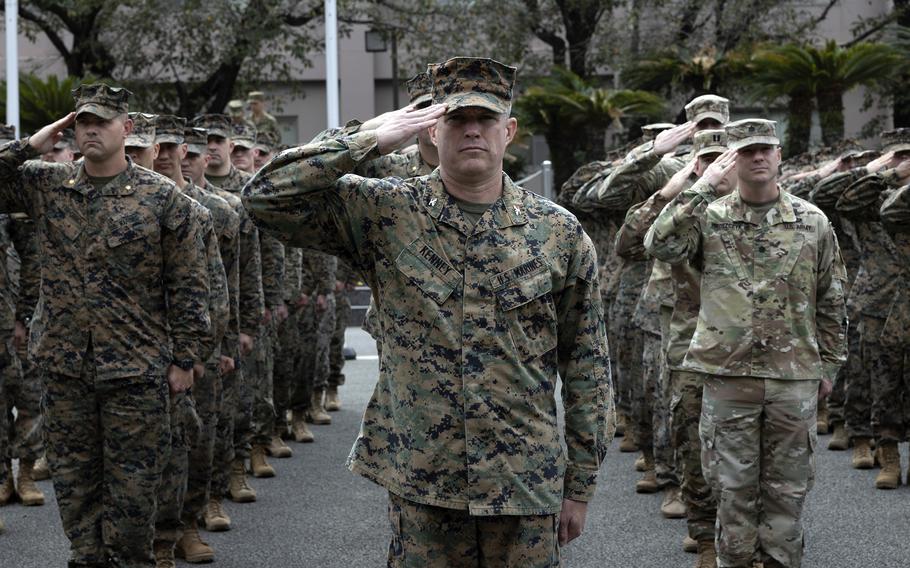
U.S. troops salute during an opening ceremony for the Resolute Dragon at Camp Kengun in Kumamoto, Japan, Saturday, Oct. 14, 2023. The 12th Marine Regiment, soon to be known as the 12th Marine Littoral Regiment, is rehearsing stand-in force concepts during the exercise. (Robert Gavaldon/U.S. Marine Corps)
CAMP FOSTER, Okinawa — The Marine Corps plans to launch a new seaborne quick-reaction force on Okinawa next month to counter Chinese maritime expansion and protect Japan’s southern island chain.
The 12th Marine Regiment will be renamed the 12th Marine Littoral Regiment during a Nov. 15 ceremony at Camp Hansen, 3rd Marine Division spokesman Maj. Clayton Groover said by phone Tuesday.
Littoral units — typically about 2,000 Marines — specialize in stand-in force operations, a key tenet of the Marine Corps’ Force Design 2030 modernization effort.
A stand-in force is a small, mobile unit inserted within range of enemy missiles to seize and hold key islands and deny enemy vessels access to surrounding seas.
The 12th Marine Regiment is rehearsing stand-in force concepts during exercise Resolute Dragon, which began Saturday and runs through Oct. 31, Groover said. Training is taking place from the northern Japanese island of Hokkaido to Yonaguni, an island 70 miles east of Taiwan.
“The redesignation will mark the next historic chapter in the Marine Corps’ commitment to designing a force that is prepared to effectively respond to the challenges of the contemporary global security environment,” a division statement said Tuesday.
It will take a “couple of years” for the unit to become fully operational, Groover said. The unit will not add to the total number of Marines on Okinawa.
Plans to transition to a new Okinawa-based littoral regiment were first announced Jan. 11 by the Japan-U.S. Security Consultative Committee, or 2+2. The new regiment is the second of at least three planned for the Indo-Pacific. The 3rd Marine Littoral Regiment was launched in Hawaii in March 2022.
Guam is reportedly being considered for the third littoral regiment, the Yomiuri newspaper reported Jan. 10, citing unnamed U.S. and Japanese government sources.
‘Protect Japan’s remote islands’
Resolute Dragon kicked off Saturday with opening ceremonies at Japan Ground Self-Defense Force Camp Kengun in Kumamoto prefecture and at Marine base Camp Kinser on Okinawa, 1st Lt. Alejandro Arteaga, a spokesman for III Marine Expeditionary Force, wrote in an emailed statement Tuesday.
The exercise will see approximately 3,300 U.S. troops, mostly from III MEF, and 4,000 Self-Defense Force personnel train on island-defense concepts, including command and control, precision fires and maneuvering.
For the first time, Marine M142 High Mobility Artillery Rocket System, or HIMARS, crews will participate in live-fire maneuvers with Ground Self-Defense Force M270 rocket teams.
Marines with HIMARS will rapidly infiltrate the Yausubetsu Maneuver Area in Hokkaido; JGSDF V-22 Osprey aircraft will fly over Okinawa in simulated casualty evacuation drills; and about 80 U.S. soldiers and Marines will work from JGSDF Camp Ishigaki, a southwestern Japanese island 160 miles east of Taiwan.
The purpose of the exercise from the Japanese perspective is to “protect Japan’s remote islands from any type of attack,” a spokesman from Japan’s Ground Joint Staff wrote in an emailed statement Tuesday. Soldiers from Japan’s Amphibious Rapid Deployment Brigade, which resembles the Marine Corps, are not scheduled to take part.
Some Japanese officials are required to speak to the media only on condition of anonymity.
Once a training scenario is issued, members of the 12th Marine Regiment will work with their Japanese allies to come up with the best strategy to detect and eliminate potential threats, Groover said.
The field training exercise portion “is important because it will allow us to transfer knowledge between our forces, share ideas and innovation, and strengthen the bond we have as those entrusted to the defense of our respective nations and to our partners,” Arteaga said. “We will build greater camaraderie, confidence, interoperability, and trust between our forces and our nations.”